Yurui Ren
Deep Geometry Post-Processing for Decompressed Point Clouds
Apr 29, 2022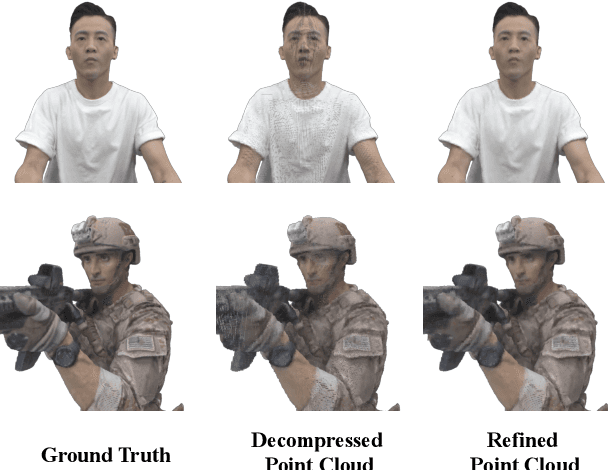
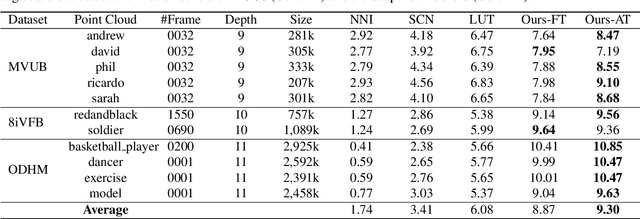


Abstract:Point cloud compression plays a crucial role in reducing the huge cost of data storage and transmission. However, distortions can be introduced into the decompressed point clouds due to quantization. In this paper, we propose a novel learning-based post-processing method to enhance the decompressed point clouds. Specifically, a voxelized point cloud is first divided into small cubes. Then, a 3D convolutional network is proposed to predict the occupancy probability for each location of a cube. We leverage both local and global contexts by generating multi-scale probabilities. These probabilities are progressively summed to predict the results in a coarse-to-fine manner. Finally, we obtain the geometry-refined point clouds based on the predicted probabilities. Different from previous methods, we deal with decompressed point clouds with huge variety of distortions using a single model. Experimental results show that the proposed method can significantly improve the quality of the decompressed point clouds, achieving 9.30dB BDPSNR gain on three representative datasets on average.
Neural Texture Extraction and Distribution for Controllable Person Image Synthesis
Apr 13, 2022

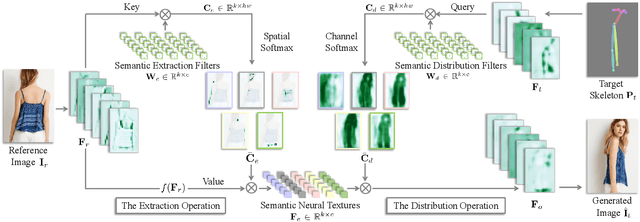

Abstract:We deal with the controllable person image synthesis task which aims to re-render a human from a reference image with explicit control over body pose and appearance. Observing that person images are highly structured, we propose to generate desired images by extracting and distributing semantic entities of reference images. To achieve this goal, a neural texture extraction and distribution operation based on double attention is described. This operation first extracts semantic neural textures from reference feature maps. Then, it distributes the extracted neural textures according to the spatial distributions learned from target poses. Our model is trained to predict human images in arbitrary poses, which encourages it to extract disentangled and expressive neural textures representing the appearance of different semantic entities. The disentangled representation further enables explicit appearance control. Neural textures of different reference images can be fused to control the appearance of the interested areas. Experimental comparisons show the superiority of the proposed model. Code is available at https://github.com/RenYurui/Neural-Texture-Extraction-Distribution.
PIRenderer: Controllable Portrait Image Generation via Semantic Neural Rendering
Sep 17, 2021



Abstract:Generating portrait images by controlling the motions of existing faces is an important task of great consequence to social media industries. For easy use and intuitive control, semantically meaningful and fully disentangled parameters should be used as modifications. However, many existing techniques do not provide such fine-grained controls or use indirect editing methods i.e. mimic motions of other individuals. In this paper, a Portrait Image Neural Renderer (PIRenderer) is proposed to control the face motions with the parameters of three-dimensional morphable face models (3DMMs). The proposed model can generate photo-realistic portrait images with accurate movements according to intuitive modifications. Experiments on both direct and indirect editing tasks demonstrate the superiority of this model. Meanwhile, we further extend this model to tackle the audio-driven facial reenactment task by extracting sequential motions from audio inputs. We show that our model can generate coherent videos with convincing movements from only a single reference image and a driving audio stream. Our source code is available at https://github.com/RenYurui/PIRender.
Combining Attention with Flow for Person Image Synthesis
Aug 04, 2021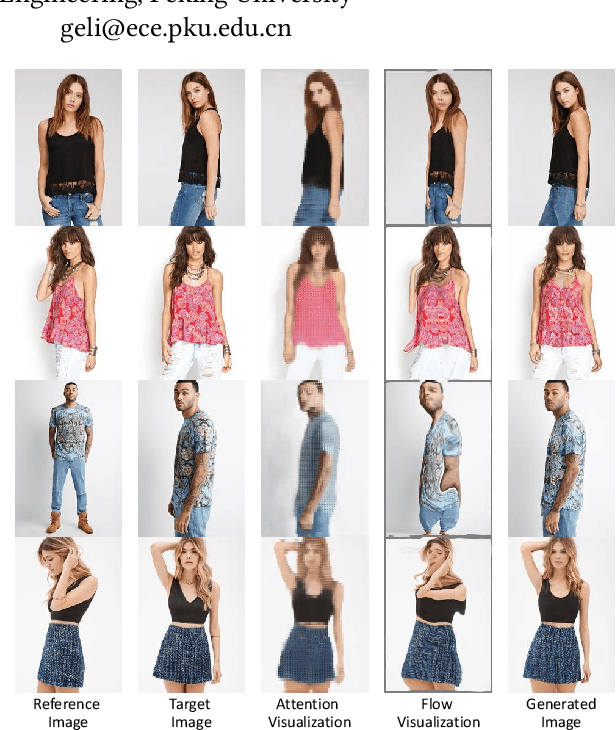

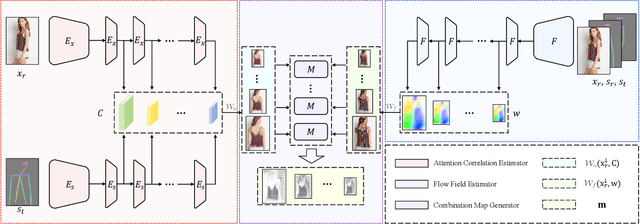

Abstract:Pose-guided person image synthesis aims to synthesize person images by transforming reference images into target poses. In this paper, we observe that the commonly used spatial transformation blocks have complementary advantages. We propose a novel model by combining the attention operation with the flow-based operation. Our model not only takes the advantage of the attention operation to generate accurate target structures but also uses the flow-based operation to sample realistic source textures. Both objective and subjective experiments demonstrate the superiority of our model. Meanwhile, comprehensive ablation studies verify our hypotheses and show the efficacy of the proposed modules. Besides, additional experiments on the portrait image editing task demonstrate the versatility of the proposed combination.
Deep Spatial Transformation for Pose-Guided Person Image Generation and Animation
Aug 27, 2020



Abstract:Pose-guided person image generation and animation aim to transform a source person image to target poses. These tasks require spatial manipulation of source data. However, Convolutional Neural Networks are limited by the lack of ability to spatially transform the inputs. In this paper, we propose a differentiable global-flow local-attention framework to reassemble the inputs at the feature level. This framework first estimates global flow fields between sources and targets. Then, corresponding local source feature patches are sampled with content-aware local attention coefficients. We show that our framework can spatially transform the inputs in an efficient manner. Meanwhile, we further model the temporal consistency for the person image animation task to generate coherent videos. The experiment results of both image generation and animation tasks demonstrate the superiority of our model. Besides, additional results of novel view synthesis and face image animation show that our model is applicable to other tasks requiring spatial transformation. The source code of our project is available at https://github.com/RenYurui/Global-Flow-Local-Attention.
Deep Image Spatial Transformation for Person Image Generation
Mar 18, 2020



Abstract:Pose-guided person image generation is to transform a source person image to a target pose. This task requires spatial manipulations of source data. However, Convolutional Neural Networks are limited by the lack of ability to spatially transform the inputs. In this paper, we propose a differentiable global-flow local-attention framework to reassemble the inputs at the feature level. Specifically, our model first calculates the global correlations between sources and targets to predict flow fields. Then, the flowed local patch pairs are extracted from the feature maps to calculate the local attention coefficients. Finally, we warp the source features using a content-aware sampling method with the obtained local attention coefficients. The results of both subjective and objective experiments demonstrate the superiority of our model. Besides, additional results in video animation and view synthesis show that our model is applicable to other tasks requiring spatial transformation. Our source code is available at https://github.com/RenYurui/Global-Flow-Local-Attention.
StructureFlow: Image Inpainting via Structure-aware Appearance Flow
Aug 11, 2019

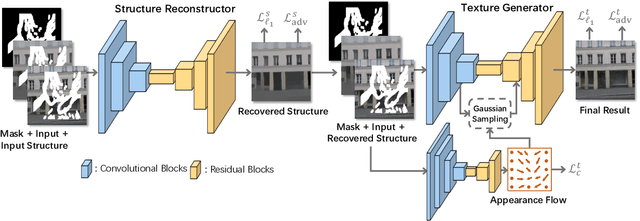

Abstract:Image inpainting techniques have shown significant improvements by using deep neural networks recently. However, most of them may either fail to reconstruct reasonable structures or restore fine-grained textures. In order to solve this problem, in this paper, we propose a two-stage model which splits the inpainting task into two parts: structure reconstruction and texture generation. In the first stage, edge-preserved smooth images are employed to train a structure reconstructor which completes the missing structures of the inputs. In the second stage, based on the reconstructed structures, a texture generator using appearance flow is designed to yield image details. Experiments on multiple publicly available datasets show the superior performance of the proposed network.
 Add to Chrome
Add to Chrome Add to Firefox
Add to Firefox Add to Edge
Add to Edge